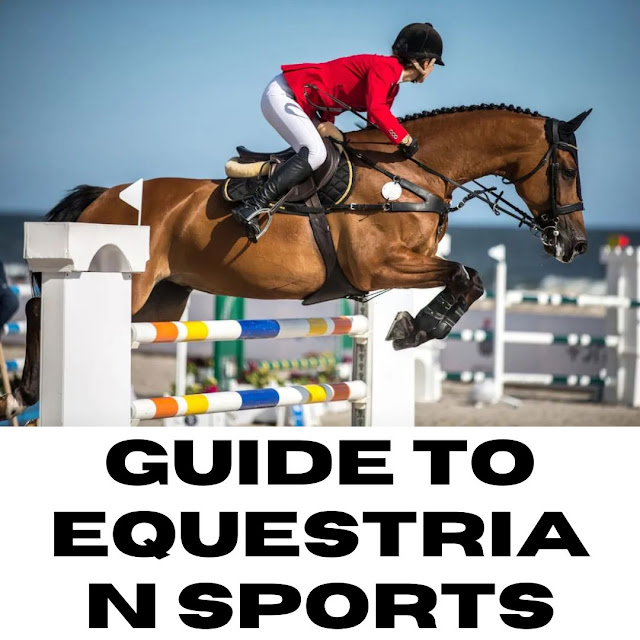The Ultimate Guide to Equestrian Sports: Events, Techniques, and Training Tips
Equestrian sports, also known as horseback riding or simply equestrianism, have been a part of human history for centuries. Combining athleticism, skill, and a deep bond between horse and rider, equestrian events are some of the most prestigious competitions in the world. Whether you're interested in competing or simply learning more about the sport, this guide will provide an overview of equestrian disciplines, essential techniques, and training tips to help you succeed in the sport.
What is Equestrian Sport?
Equestrian sport involves competitive horseback riding, where riders participate in various events that test their skills, control, and communication with their horses. These events can take place on both competitive and recreational levels, and there are several different types of equestrian sports, including dressage, show jumping, eventing, and reining. Each discipline requires unique skills and techniques, making equestrianism a multifaceted and exciting sport.
Popular Equestrian Disciplines
Dressage:
- Often referred to as "horse ballet," dressage is a discipline that involves riding the horse through a series of predetermined movements known as "tests." The rider’s goal is to demonstrate the horse’s obedience, flexibility, and smoothness in executing precise movements. Dressage is widely regarded as one of the most elegant and technical equestrian disciplines.
Show Jumping:
- Show jumping is a thrilling discipline where horses and riders must navigate a series of jumps in an arena within a set time limit. The goal is to complete the course without knocking over any obstacles or exceeding the time. Show jumping requires a combination of speed, accuracy, and careful control to succeed in this high-pressure event.
Eventing:
- Eventing is a three-phase competition, often considered the "triathlon" of equestrian sports. It includes dressage, cross-country, and show jumping. This discipline tests the rider’s versatility, endurance, and skill in handling the horse over varying terrain and obstacles. Eventing is one of the most demanding and rewarding equestrian disciplines.
Reining:
- Reining is a Western-style equestrian event where the rider guides the horse through a set pattern of movements, including spins, sliding stops, and circles. The goal is to showcase the horse’s agility, speed, and responsiveness. Reining is popular in Western riding competitions and is known for its precision and control.
Driving:
- In driving, riders control a horse-drawn carriage or cart. The event tests the driver’s ability to guide the horses through a series of obstacles or a timed course, demonstrating control and precision. Driving is an exciting discipline that combines horsemanship and technique.
Essential Techniques for Equestrian Sports
Balance and Posture:
- Good posture and balance are essential for maintaining control and communication with the horse. Riders should sit upright in the saddle, keeping their shoulders back and their hands steady. Proper balance allows the rider to stay in sync with the horse’s movements and respond effectively to changes in pace or direction.
Rein and Leg Aids:
- Riders use their reins and legs to communicate with the horse. The reins help guide the horse’s head and neck, while the legs provide cues for direction, speed, and movement. Learning the correct use of rein and leg aids is crucial for effective communication and control.
Focus and Timing:
- Equestrian sports require a high level of focus and timing. Riders must be alert and aware of their horse's behavior and movements. Timing is especially important in events like show jumping, where riders need to anticipate jumps and adjust their approach accordingly.
Horse Training:
- A well-trained horse is crucial to success in equestrian sports. Training a horse involves building trust, improving responsiveness, and teaching specific movements or patterns. Consistent practice, patience, and positive reinforcement are key to developing a strong partnership between horse and rider.
Tips for Getting Started
Find a Qualified Instructor:
- If you're new to equestrian sports, it's essential to take lessons from a certified riding instructor. A knowledgeable instructor will teach you proper techniques, and safety measures, and help you develop the skills needed to excel in your chosen discipline.
Choose the Right Horse:
- Selecting the right horse for your level of experience and discipline is crucial. Some horses are better suited for beginners, while others excel in more advanced competitions. Make sure to consult with trainers and professionals to find a horse that matches your abilities and goals.
Invest in Proper Gear:
- Safety is paramount in equestrian sports. Riders should invest in high-quality gear, such as a well-fitting helmet, riding boots, gloves, and appropriate saddlery. Proper gear ensures comfort, safety, and optimal performance during training and competitions.
Practice Regularly:
- Regular practice is essential for enhancing your riding skills. Spend time training in different disciplines, work on building trust with your horse, and participate in local competitions to gain experience. Regular practice will help you develop better control, timing, and confidence.
Conclusion
Equestrian sports offer a unique blend of athleticism, artistry, and teamwork. Whether you’re interested in competing in dressage, show jumping, or eventing, mastering the essential techniques and understanding the fundamentals of the sport will set you on the path to success. By practicing regularly, working with a qualified instructor, and building a strong partnership with your horse, you’ll be ready to take on the challenges of equestrianism and enjoy the rewarding experience of horseback riding.









0 Comments